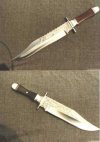A few days back a firearm engraver and new knife maker spoke with me over the phone about having me heat treat a couple heavily embelished O1 blades. He questioned me about whether I should stress relieve the 1/8 inch stock O1 blades. I asked him questions about how he machined it. After assuring me he only grinded a little on one side then the other until finished, I advised not spending the extra few bucks for stress relieve but that I would look at them and do it if I thought a good idea.
One blade is a classic drop point; no outstanding HT problem. The other though, wow, what a needle point. It is clipped and has a very slow edge curve to tip. A long thin point. It was NOT a question of warp but how badly. A beautiful profile but I knew this one was trouble.
I decided to HT as usual; no stress relieve or adjusting quench temperature, etc. After all, I was going to have to straighten and re-heat treat with adjustments anyhow. Why not go for broke at first. Guess what - no warp. The only thing that makes any sense to me is the balanced machining he insisted he did. I don't know but its the only thing I can assume.
RL
One blade is a classic drop point; no outstanding HT problem. The other though, wow, what a needle point. It is clipped and has a very slow edge curve to tip. A long thin point. It was NOT a question of warp but how badly. A beautiful profile but I knew this one was trouble.
I decided to HT as usual; no stress relieve or adjusting quench temperature, etc. After all, I was going to have to straighten and re-heat treat with adjustments anyhow. Why not go for broke at first. Guess what - no warp. The only thing that makes any sense to me is the balanced machining he insisted he did. I don't know but its the only thing I can assume.
RL

